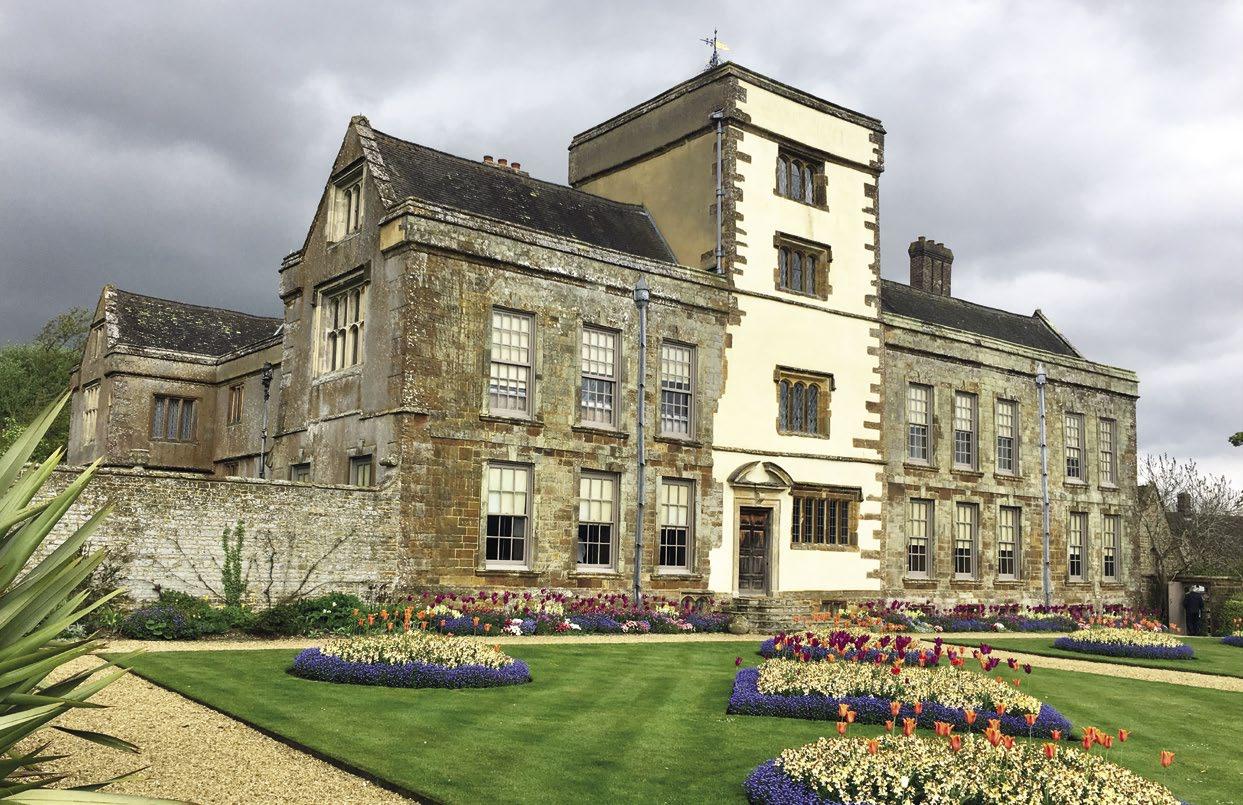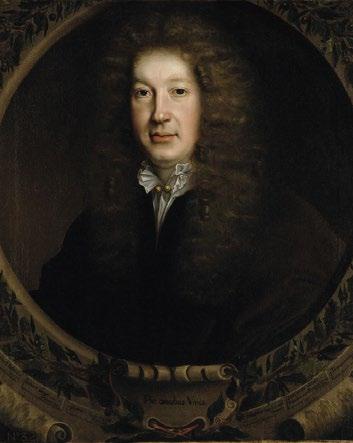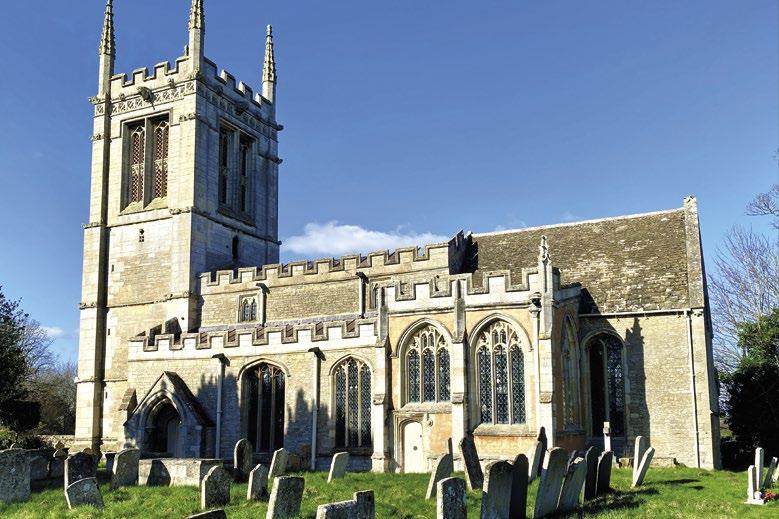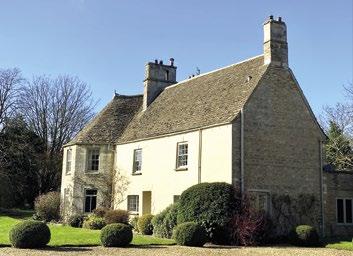
8 minute read
HISTORY
Canons Ashby, home of the Dryden family and now a National Trust property
Glorious John
Northamptonshire’s Poet Laureate
Ithink many living in Northamptonshire will have heard the name John Dryden at one time or another. As one of Northamptonshire’s most famous sons, there are many buildings and institutions bearing his name, but who was he? And what made him so highly esteemed by society, yet ignored by his Northamptonshire family?

The Dryden family was established in Northamptonshire around 1550, when the first John Dryden from Cumbria married a wealthy Banbury heiress, Elizabeth Cope. They settled at Canons Ashby near Daventry, building a manor house now under the care of the National Trust. The couple were fervent Puritans, and against the old Roman Catholic Church and the trappings of monarchy. This family stance remained consistent through subsequent generations.
Portrait of John Dryden by John Michael Wright, circa 1668
Laura Malpas delves into the history of John Dryden
Those relations who dared to practice Catholicism were excluded from the inner circle of the family. Our John, John the poet, was the great grandson of the first John Dryden, and born in 1631 in the Northamptonshire vicarage of Aldwincle, where his maternal grandfather was the parish priest. It seems that the Aldwincle Drydens were on good terms with their cousins at Canons Ashby, and young John in time developed a romantic attachment to Honor, the eldest daughter of his Uncle, Sir John.
Young John grew up in troubled times. By the time he was ten years old England was in the grip of conflict between the demands of the Roman Catholic monarch Charles I and Parliament. His family, also Parliamentarians with Puritan leanings, moved to Titchmarsh, just across the Nene valley.

Young John, clearly a bright boy, was sent to Westminster school with a scholarship where he studied the classics. He published his first poetry while still a pupil, and them went on to Trinity College, Cambridge where he received his BA.
Dryden first wrote to celebrate the heroism of Oliver Cromwell, but then, despite his family’s political position, went on to use his literature to entertain and flatter important figures, including the newly crowned King Charles II. In the hedonistic Restoration years, the demand was high for all kinds of entertainment, especially theatre, and Dryden began to write plays.
However, John had seriously blotted his copybook with the family at Canons Ashby. Letters show that there was an understanding between him and his beautiful cousin Honor. There are even hints that they may have ‘anticipated’ a wedding, in relationship terms. But with John now embracing the frivolous world of theatre and London high society, and a move towards Roman Catholicism to please his patrons, marriage to Honor was now out of the question. The Canons Ashby Drydens were still practicing Puritans, and Honor remained unmarried for the rest of her life.

In 1663, John had married the sister of his theatrical partner Sir Robert Howard, both a Royalist and a Roman Catholic. By 1665 he had made his reputation with ‘The Indian Emperor’, a heroic drama which was a box office hit. His income was healthier than his marriage proved to be. Lady Elizabeth Howard had come to the marriage with a compromised reputation. It seems that even though John was considered socially inferior, Elizabeth’s brothers had to bully him into marriage. Elizabeth was not considered a good catch, for she had enjoyed an intimate relationship with a dissolute nobleman, and her personality was considered unreliable. However, they both shared love for their children, if not so much for each other. Dryden also enjoyed the intimate company of at least one actress.
John’s literary work, poetry, prose, and plays made him fashionable and popular. He impressed and flattered some of the most important men in the England, and within a few years was elected to the Royal Society, awarded a master’s degree by the Archbishop of Canterbury, created Historiographer Royal, and gained his most famous accolade as the first officially appointed Poet Laureate.
This acclaim made him overconfident, and he enjoyed poking fun at his contemporaries with witty satirical verse. This did not increase his popularity with them. According to a newspaper of the time, a poem caused his rivals, thought to have been led by Lord Rochester, to hire ruffians to teach John a lesson.
John Dryden’s birthplace in Aldwinclde Aldwincle Church

John survived and offered a reward of £50 and a Royal pardon to learn the identity of who was behind the assault, but to no avail. However, this hardly affected his productivity, as he continued to write, mostly successfully. As he grew older, he turned his pen to religious matters, moving further towards Roman Catholicism. After the death of King Charles II, and the coronation of James II, a Catholic, John fully converted. This proved a problem three years later, when James lost his throne to the Protestant William and Mary. John refused to swear an oath of allegiance to the new monarchs and lost his laureateship to a rival. However, he continued to make a living writing poetry and translating classic works. John died of gout in 1700, aged 69, with his reputation intact. He was buried and memorialised with honours in Westminster Abbey. And in his will, he left money and property to found a school for the poor children of Northampton.
John Dryden was seen as a leader of cultural life in Restoration England. In literary circles his lifetime became known as ‘The Age of Dryden’ and he was referred to as ‘Glorious John’. He has remained a widely read and quoted author, who innovated literary styles and forms, whose contribution is still appreciated today.
And as a footnote from his disapproving Canons Ashby family… On the death of Robert Dryden in 1708, the family had run out of direct male heirs. Although Robert and John had been friends, the family could not tolerate a Roman Catholic inheriting their Puritan possessions. John’s son inherited the baronetcy, and should also have inherited the estate, but the family objected. Cousin Edward inherited instead as he was a Protestant. It was only after the fact that the family discovered that Edward’s wife was from a Roman Catholic family, but that is indeed another story.
For more information, read John Dryden and His World by James Anderson Winn
Cosworth CEO and Chairman Hal Reisiger with Andrew Lewer

Recently I met up with Cosworth boss Hal Reisiger and his Group Marketing Director Nick Greenway at their Headquarters on St James Mill Road. Cosworth is a worldclass high-performance engineering and technology firm, an important part of the cutting-edge Motorsport Valley family mainly based here in Northamptonshire and one of those companies many people would be able to name as known for their association with Northampton.
We had a good catch-up on their business opportunities and risks. I came away with the sort of information that is very useful for me to raise in my meetings with various Government departments to help them shape and adapt their policies.
Cosworth devotes huge resources towards research and development, making it a truly pioneering business - especially around the high growth, high yield areas of electric powertrains, battery technology and software development.
Cosworth is the sort of growth business that is vital for the future economic security of both the Northampton and the wider British economy. It has ambitious expansion plans, but there are risks. Cosworth wants and needs to train up a new generation of skilled workers and the sector is struggling to find enough apprentices who have a talent for engineering and software technology. This is a huge opportunity for local schools and colleges to link in and work with Cosworth and other high performance technology companies to inspire and create the next generation of software and engineering pioneers. Companies like Cosworth are willing to invest heavily on the next generation of talent entering the world of work and are especially keen to have female STEM specialists. This is a win-win collaboration opportunity for local industry and schools.
Back in Parliament I chair the All Party Parliamentary Group for Small and Medium Housebuilders. This skills shortage is hitting the construction industry too, which is why I launched an Inquiry into skills and the SME Housebuilding sector. We will be taking evidence from those with the hands-on and thus expert knowledge in the sector and beyond, to look at what the main constraints are and how we can alleviate the shortage. It is all too easy to say ‘we need more skills’ in our economy, but which skills, at which level and delivered in which way is not always as easy to ascertain. The results of this inquiry and the accompanying report will be presented to Government in due course and will be published online.
I need not remind anyone of the critical nature of building enough houses to meet not only the current demand, but burgeoning future demands. New housing stock and getting the balance right between social rented, discounted and full market is critical for unlocking future economic growth, giving your children and grandchildren the opportunity to live in and indeed to own a home.
Skills for work in a changing and uncertain economy, skills to provide the much-needed housing stock for our country: Two key and very much linked challenges that I want to see Northampton leading the way in answering.










